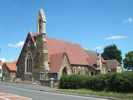 Ranskill Ranskill
St Barnabas
History
The village of Ranskill lies on the Great North Road approximately five miles north of Retford.
No church is mentioned in Domesday Book and the land at the time of the 1086 survey was described as waste; the Archbishop held it. Although there is no mention of a priest, nearby Torworth, only half a mile to the south, which now has no church, was described in Domesday as being held by Azor the priest, and was also waste. Clearly there was some ecclesiastical presence in the vicinity.
There is no reference to a medieval church in the village but at the Reformation Blyth Priory held lands in Ranskill generating income from tithe corn and hay. Also, in 1553, the messuage and 30 acres of meadow, then in the tenure of Hugh Smyth in Ranskill, which lay in Blyth parish, were given by King Edward VI to the priest celebrating in Blyth. The same year the king also gave the manor and township of Ranskill to Robert, Archbishop of York.
The church dedicated to St Barnabas was erected in 1878 as the sister church to St Mary’s in Blyth. It is a stone building possibly designed by Ewan Christian but apparently executed by Charles Baily of Newark, consisting of chancel, nave, extension on the south-east side, and a turret with a single bell. The contractor was Mr Marrison. The church was dedicated by the Bishop Suffragan of Nottingham, Edward Trollope, on 11 June 1878. It cost around £1000 to build and could accommodate 200 sittings.
The chancel, along with an enlargement of the vestry, was added in 1893. A dedication festival was held in July 1894 with special service and a well-attended public tea. A new pulpit had also been erected by special subscription to the memory of the Reverend Charles Hankey, provost in charge 1887-1890.
In 1902 a church room was built on a site donated by a member of the Pollitt family. It cost £50 to build and was the largest facility for community gatherings in the village.
In 1912 there were 59 scholars listed on the books of the Sunday School.
In 1984, two pews were removed and a third turned round to face the other to create a meeting area in the church. Subsequently all the original pews were removed and the church now has modern style chair seating.
In 2017 services were held every Sunday except where there was a 5th Sunday of the month, and various groups met in the church during the week along with other social events throughout the year.
| 




